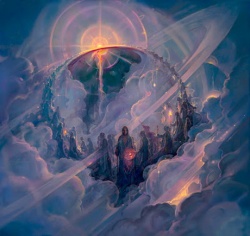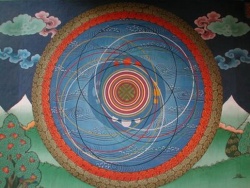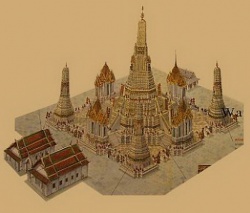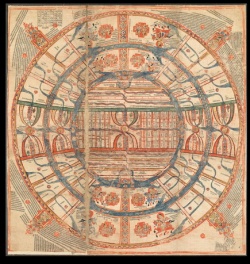The Potential of Emptiness: Vacuum States of Space and Consciousness
Science does some of its best work in a vacuum. Radio, television, computers, and many other life-changing and philosophy-boggling advances are the results of work with the vacuum. As it turns out, Nature may abhor a vacuum, but technology loves it.Like Western physical science, Buddhist contemplative science also makes discoveries using vacuum states. Since the concept of emptiness is integral to Buddhist philosophic, religious, and cultural traditions, discovering wisdom in emptiness requires no paradigm shift. As technology loves a vacuum, so does insight.
Science, both physical and contemplative, uses analogy and metaphor to extend understanding and predictive ability. Analogy and metaphor are particularly important in descriptions of realms outside the reach of the five senses. I will be drawing parallels between two manifestations of the vacuum -- that of the outer world, the physical vacuum studied by physicists, and that of the inner world, the mental vacuum studied by Buddhist contemplatives -- for the purpose of extending metaphor and thereby extending understanding.
Generally speaking, Western science investigates physical phenomena and Buddhist science investigates consciousness. Since Western science has as yet no method of identifying or measuring consciousness, its study as a natural phenomenon has been marginalized in modern Western science. The reverse is true in Buddhist cultures. Not known for technological innovations, in Buddhist cultures the study of consciousness is an expertise. Some rapprochement is in order, some sharing of skills and knowledge, and to facilitate this process, I will highlight the known parallels of the twin poles of the reality spectrum – the outer vacuum of physical science and the inner vacuum of contemplative science.
Preoccupied with the stunning discoveries of early science, only in the closing decades of the last century did Western scientists begin to grapple with the nature of consciousness. At this time, the West remains without an objective definition and without an objective means for detecting the presence or absence of consciousness. We have sciences of quarks, the Big Bang, galactic clusters 12 billion light years away, but we don’t have a science of what makes it all possible, consciousness. Within Western science, consciousness is an anomaly.
There are some striking analogies between Western science, which studies primarily the physical world, and Buddhist contemplative science, which studies consciousness. First, a historical perspective of Western science. In the seventeenth century, Galileo (1564-1642) refined the telescope and rigorously examined celestial phenomena. His discoveries provided compelling evidence in support of the heliocentric cosmology of Copernicus. As a naturalist, Galileo placed his attention outwards. As a devout Catholic, Galileo’s goal was to understand the mind of the Creator by understanding His creation. Historically, Galileo shares credit for starting what was later called the Scientific Revolution and his student, Evangelista Torricelli (1608-1647), Italian mathematician and physicist, started a revolution within that revolution. Torricelli was first to remove everything material from a container within the limits of the technology of his time. Torricelli defied Nature and started the revolution of the vacuum.
In the seventeenth century, the onset of the Vacuum Revolution was not newsworthy. You can get a little bit of empty space, so what? Much better to make something. In the last three centuries, however, the vacuum has been used in hundreds of technological applications: thermometers, thermoses, radios, refrigerators, electron microscopes, x-ray tubes, particle accelerators, and, very significantly, instruments for extending our senses to more closely investigate the nature of reality. In fact, modern life as we know it depends on the vacuum.
Now step outside of Western civilization, to sixth century B.C.E India where Siddhartha Gautama was receiving contemplative training. I will call Gautama a naturalist because, like the founders of the Scientific Revolution, he was intent on exploring the world experientially and rationally, as free from subjective bias as possible. It’s unlikely that Gautama thought of himself as a founder of a new religion, for at that time in India there was no term or concept for “religion” as we conceive of it in the modern West.
Gautama, age 29, trained in a contemplative practice to create a vacuum state within his own mental space, a vacuum state of consciousness. Guatama’s first teacher, Alara Kalama, taught him techniques to enter a state described as “nothingness” in which the mind is voided and disengaged from the physical senses. This is a state of concentration of luminous awareness of nothing, a state more subtle than meditative stabilization, which is also described in the early literature. Gautama accomplished the state of “nothingness” very rapidly, apparently a prodigy. He wanted to go further and trained with another contemplative, Uddaka Ramaputta, who brought him to a state even more subtle than nothingness, a state disengaged from the phenomenal and sensual world, drawn into a space purely of the mind, and then disengaging even from mind. This is subtle. When even this was accomplished, Siddhartha Gautama was not satisfied; he wanted to go further.
What Gautama did next was revolutionary. Having refined the mind, having developed extraordinary states of attentional stability and vividness, Gautama used his mind as an instrument to actively explore the nature of reality. Gautama began to explore consciousness itself and started what we can call, from a historic vantage point, a Noetic Revolution. By using states of meditative concentration to rigorously examine mental and physical phenomena, Gautama began a contemplative science parallel to the physical science of the West. The techniques are similar, the tools are very different.
The parallels between the inner science of Gautama and the outer science of Galileo lead to extremely useful metaphors. Just as Galileo did not invent the telescope but refined it as a tool for observation of the planets, Gautama did not invent meditative concentration (samadhi) but was first to use extremely refined, focused, magnified awareness as a tool for investigating the nature of consciousness. As the West has developed different tools for the investigation of the outer world, Gautama devised different types of mental vacuums to explore and develop consciousness. Gautama’s methods, for example, extended mental perception, explored consciousness and related phenomena, and cultivated wholesome mental traits. Gautama was not interested in knowledge for knowledge sake, but believed that investigating reality should be beneficially transformative. Benefit has remained a central priority in Buddhist practice ever since.
As people of the seventeenth century did not foresee much use for the physical vacuum, contemporary Westerners may wonder what use there could be for the mental vacuum. Like the physical vacuum, the mental vacuum presents a surprising set of qualities and potentials. What is left when the turbulence -- memories, thoughts, desires, emotions, mental images -- has been released, is not a state of empty-headedness. Instead, the mental vacuum is a state that is luminous and vivid with an extraordinary power for concentration.
Gautama, as a naturalist, turned away from the dogma of the dominant religion of his time and studied the world rationally and empirically. Gautama’s working hypothesis was that physical and mental events take place due to causes and conditions within the natural world. This is the same hypothesis held by the founders of Western science and was as innovative in sixth century India, when phenomena-- hailstorms, earthquakes -- were attributed to supernatural agencies, as it was seventeenth century Europe. Naturalism, just like being of benefit, became central to the theory and practice of Buddhism.
Now let’s examine the physical vacuum. What is it? In the words of James Clerk Maxwell, “The vacuum is that which is left in a vessel after we have removed everything which we can remove from it.” The vacuum is defined as the lowest possible energy state of a volume of space. What can be removed depends, of course, on technology. The vacuum itself is shapeless but it may assume specific forms as it takes on the configurations of mass-energy resulting in what is conventionally called the “real world.” The phrase “configurations of mass-energy” refers to everything that is around us. “Excitations of the vacuum” are commonly described as being like the surface waves on a pond. Why is an oscillation of an abstract field quantity in space not an actual oscillation of space itself? The field we are concerned with is not a substance. It is an abstract quantity, a very useful abstract quantity, but still considered by physics as an abstract quantity. Therefore, configurations of mass-energy are oscillations of an abstract quantity in empty space and no objectively real substance actually oscillates. Mass itself is sometimes referred to metaphorically as frozen energy. Additionally, general relativity theory tells us that fluctuating masses of the vacuum, despite their abstract nature, cause curvatures of space.
The physical vacuum is very weird. As described, an oscillation of an abstraction is substantial enough to curve space. But space is not so substantial either. We hear from quantum mechanics that within space, virtual particles and antiparticles spontaneously emerge from a vacuum and become “real” little particles only if you x add energy. When energy is added to virtual particles, the resulting longevity entitles them to be called “real.” If no energy is added, virtual particles dissolve right back into the vacuum. It is like instant soup without the soup, but instead of adding water, add energy.
The physical vacuum has two divisions, both having a parallel in contemplative descriptions of vacuum states of consciousness. The two divisions of the physical vacuum are (1) the false vacuum and (2) the true vacuum.
A false vacuum is the lowest possible energy state under the circumstances, but it is not completely devoid of energy. The false vacuum has energy and structure and is not perfectly symmetrical. Physicists work with false vacuums on a day-to-day basis. A false vacuum is like water that falls to a lower state, cooling and freezing as it releases energy. The false vacuum is often referred to as “frozen.”
The true vacuum is called “melted.” Scientists are not sure what remains once everything that nature allows us to take from a well-defined space has been removed. Again, the false vacuum is determined by the limitations of technology. But the true vacuum depends on all the laws of nature, whether they have been discovered yet or not. The true vacuum would be perfectly symmetrical. Unlike the false or frozen vacuum, in the true or melted vacuum, particles, fields, and electricity are undifferentiated. In the false or frozen vacuum, these entities are distinct from each other. To understand the true vacuum, it is necessary to thoroughly understand the false vacuum.
Scientists speculate that quantum mechanical fluctuations within a vacuum initiated not only the stuff of our world but also space-time itself. Perhaps the absolute nothingness discussed in philosophy and religion should be considered as a state wholly innocent of laws, space, and time – a state in which nothing exists but possibilities.
Now consider consciousness, inner space, the space in which dreams, mental images, thoughts, emotions, desires, hopes and fears, joys and sorrows, all arise. The fundamental discovery of Buddhist contemplatives is that the nature of consciousness is empty and luminous. Buddhist terminology is very precise in describing the characteristics of consciousness. Consciousness is empty for it is, like space, intangible and unsubstantial. Consciousness is luminous in being clear cognizance, or knowing. Additionally, consciousness can manifest in all kinds of forms. As we have just heard from physics, space also manifests, also takes on form. The difference between space and consciousness is that consciousness not only takes on form but also has a quality of being aware which, as far as we know, space does not have.
If you could observe bare consciousness, without mental states, it would appear empty and luminous. What obscure the luminosity of consciousness are thoughts, mental constructs, dullness, excitation, and an endless array of mental contents. In many aspects of science, special conditions are necessary to investigate natural phenomenon. In contemplative science, the mandatory prerequisite for the investigation of consciousness is getting to its ground state, a vacuum.
Entering the ground state of consciousness can be done. We have already drawn a parallel between physical vacuums and vacuum states of consciousness. Now we take the analogy deeper. As physicists distinguish between false and true vacuums in the physical world, contemplatives distinguish false and true vacuum states of consciousness. The false vacuum state of consciousness is known in Buddhist literature as the bhavanga, from Pali and Sanskrit, which is a kind of substrate consciousness. The bhavanga is a relative ground state of consciousness, more vacuous than deep sleep and free of mental dullness, in which all mental activation is dormant. The bhavanga, is an empty, luminous state of awareness and, like its analog, the false vacuum of physics, it is a potentially creative state.
Contemplatives follow a variety of procedures to create a mental vacuum. One common strategy is to powerfully contract consciousness by focusing on a small mental image, the smaller the object on which consciousness is focused, the more potent the consciousness becomes. When the mind is so concentrated that all physical senses have gone dormant and awareness is luminous and pure, the image is released. What is left? An absence, a vacuum state of consciousness characterized by bliss and luminosity, without thoughts, mental constructs, or images. In this state, bliss, luminosity, and non-conceptuality are experienced distinctly, just as the various attributes of the false vacuum of physics -- particles, fields, and so forth -- are distinct from one another.
Since differentiating, accessing, and utilizing different states of consciousness is somewhat unfamiliar terrain in the West, I’ll go into a bit of detail here explaining the bhavanga, or false vacuum state of consciousness. The bhavanga is the individual ground of becoming from which all mental activities arise, both positive and negative. Positive states include generosity, friendliness, and compassion. Negative states include malice, cruelty, and spite. Negative activations of the mind warp the mind, destroying its equilibrium. Positive activations restore the mind to a state of relative balance. However, distortions of the space of consciousness occur only when energy is invested into mental activities, positive or negative. Investing energy in mental events is called grasping or identification. When we give energy to an idea, thought, or emotion that emerges spontaneously from the bhavanga, it changes status from virtual to “real,” analogous to the potentials of the false physical vacuum. With the energy of identification, the now “real” mental event starts influencing other mental activities as well as physical behavior. The bhavanga spontaneously, effortlessly, and often unpredictably gives rise to a wide range of mental activations. If one does not grasp onto them or identify with them, they tend to persist for relatively brief periods and do not perturb the equilibrium of the mind. Grasping onto and identifying with the natural phenomena of the bhavanga, the false vacuum of the mind, infuses them with energy. In a mixed terminology of Buddhism and physics, you could say that mental activations arise virtually from the ground state and then, if no energy is infused into them, disappear back into the ground.
When a mental activation is infused with energy through grasping or identification, the activation changes status from virtual to “real.” Having an investment of energy, the mental event obscures the substrate consciousness by interacting with other mental, verbal, and physical activity, and leaves its imprints upon the substrate consciousness. These activities and their residue in the substrate are called karma and karmic imprints, respectively, and can accrue indefinitely with positive and negative imprints canceling each other out. This is the contemplative understanding of the nature of consciousness that is the foundation of the Buddhist concept of karma.
According to Buddhism, the bhavanga is not a true or absolute vacuum because precognitive conceptual structuring of awareness still persists. Even though concepts such as subject and object are not manifest, awareness is still structured by conceptual and biological influences. Like its analogue in physics, the false vacuum of consciousness, the bhavanga, appears to be empty but has structure and energy.
Vacuum states of consciousness, whose potentials go largely unrecognized in the West, may be responsible for as yet unexplained phenomena, such as the so-called placebo effect and other mental effects on the body that originate from a source deeper than conscious volition. Buddhist contemplatives view the substrate consciousness as the source of creativity, genius, and other potentials that can be accessed when it is drawn into consciousness. However, to tap the potentials of the substrate consciousness, it is necessary to create a mental vacuum. Studies have shown that all geniuses have something in common -- exceptional degrees of sustained voluntary attention, the same ability cultivated by yogis as a spring board to developing vacuum states and exploring consciousness.
Like the false vacuum states, the true vacuum states of physics and consciousness have similarities. In Buddhist literature, the true vacuum is called primordial awareness and, like the false vacuum state, it can be realized experientially. Most Western cognitive scientists believe that the mind cannot be emptied of content; conceptual constructs and impulses are built-in, so the mind always has content. In the West, there is a good deal of cultural anxiety concerning emptiness. “I think, therefore I am,” is Descartes’ famous line. But Descartes also worried what happened when he was not thinking … and then quickly moved on.
Buddhist contemplatives state that an absolute vacuum of consciousness exists and can be ascertained by direct experience. How? In a way that is unlike any other form of knowledge. The absolute vacuum of consciousness is knowing in a way that is non-conceptual, by means of identity, without any sense of subject/object duality, and simultaneously not-knowing in all the ordinary ways. The realization of the true vacuum of consciousness is by way of achieving the false vacuum of consciousness.
With finely honed awareness, a mind stable, vivid, and highly focused, one can experientially probe all mental phenomena. The primary tool for this investigation is the false vacuum of consciousness, a state that is a clean lab without noise or pollution, in which mental events arise. Within these conditions, instead of settling for bliss, one can probe deeper into the nature of mental activity. From where do mental events arise and into what do they dissolve? What is the nature of the mind that can be probed and identified in this way? This is an ontological probe into the space of the mind itself.
Buddhists contemplatives have used vacuum states to investigate the nature of the mind for 2500 years. The collective result is the discovery that there is no thing that is the mind. In the state of not finding, awareness comes to rest in a state of luminous, empty, non-duality, without any sense of subject or object. This is the absolute vacuum of consciousness and is utterly free of all conceptual constructs, including space and time, mind and matter, even notions of existence and nonexistence. In this state, bliss, luminosity, and non-conceptuality are undifferentiated. Like the true vacuum of external space, the true vacuum of consciousness is one of perfect symmetry, for it is non-local, timeless, homogenous, and devoid of internal differentiation. This absolute ground of consciousness is called the Great Perfection.
The Buddhist contemplative science, in parallel to Western physical science, describes two types of vacuums: (1) The false vacuum, or bhavanga, the relative ground of becoming, out of which each individual mind-stream emanates; and (2) the true vacuum, or Primordial Awareness, the absolute state of phenomena out of which space and time, mind and matter, everything in the universe, emerge.
Now to wrap this up a bit. Western cognitive scientists generally regard dreaming, imagination, and waking experience as basically the same phenomenon except that waking experience is constrained by sensory stimuli from the external world. Dreaming, imagination, and waking perception are all considered to be creations of the mind. Physicists describe the physical world as configurations of mass-energy consisting of oscillations of abstract quantities in empty space that may or may not exist independent of a system of measurement.
When cognitive science is combined with physics the result is something like: Everyday waking experience is an illusion constrained by the oscillations of abstract quantities in empty space – a statement that raises questions about the nature of reality and our relationship to it. If we also consider that sensory experience of space and all concepts of space and time occur in the space of consciousness, the questions deepen.
Like physicists, Buddhists have investigated the nature of physical phenomena. Using contemplative techniques, Buddhist have found physical phenomena to lack any inherently objective nature independent of the conceptual framework within which they are identified. Contemplatives use the same techniques to investigate the nature of mental phenomena. What they discover is that consciousness itself lacks inherent identity independent of the conceptual framework in which it is identified. Contemplatives have discovered that the mind is just as empty of inherent existence as the external physical world.
Finally, contemplatives have taken the investigation of phenomena a step further and report that the division between external physical phenomena and internal mental phenomena is empty of inherent existence. The distinction between external and internal is an illusion; internal and external space are ultimately non-dual. This is the absolute space of phenomena. In Buddhist literature, this is the Great Perfection out of which the entire universe originates.
The Buddha summed up his investigations of reality with this statement: “All phenomena are preceded by the mind. When the mind is comprehended, all phenomena are comprehended.” By “mind,” the Buddha was referring to the deepest state of consciousness, primordial awareness, true vacuum, state, which is what they study. The cooling of the original true vacuum is believed to have liberated enormous amounts of energy that gave rise to quarks, electrons, and eventually all of life.
His Holiness the Dalai Lama recently described the Great Perfection:
- “Any given state of consciousness is permeated by the clear light of primordial awareness. However solid ice may be, it never loses its true nature, which is water. In the same way, even very obvious concepts are such that their ‘place’, as it were, their final resting place, does not fall outside the expanse of primordial awareness. They arise within the expanse of primordial awareness and that is where they dissolve.”
The Dalai Lama is saying that the absolute ground state awareness is primordial awareness, the fundamental ground from which everything, space-time, mass- energy, mind-matter, all arise and into which they eventually dissolve.
Over the past four centuries, Western science has made enormous progress in understanding the nature of external physical phenomena and the space in which, and from which, they arise. But scientific progress into the nature of the mind and consciousness has been far more limited. Buddhist contemplative science, on the other hand, has made innumerable discoveries concerning the origins, nature, and potentials of consciousness, but it lacks the physics, chemistry, and biology that have been developed in the West. When these two great traditions of experiential and rational inquiry are integrated, we will see a Noetic Revolution that will be of enormous benefit for humanity.
This essay was originally presented by Alan Wallace at a conference he organized on the theme “Nothing in Common: Scientific and contemplative views on nothing,” on May 12, 2001, at the University of California, Santa Barbara. It has been edited into its present form by Lynn Quirolo, who also edited his book Buddhism with an Attitude: the Tibetan Seven-Point Mind-Training.
Source
B. Alan Wallace
Edited by Lynn Quirolo
Published in Network: The Scientific and Medical Network Review, Dec., 2001, No. 77, pp. 21-25.
alanwallace.org





